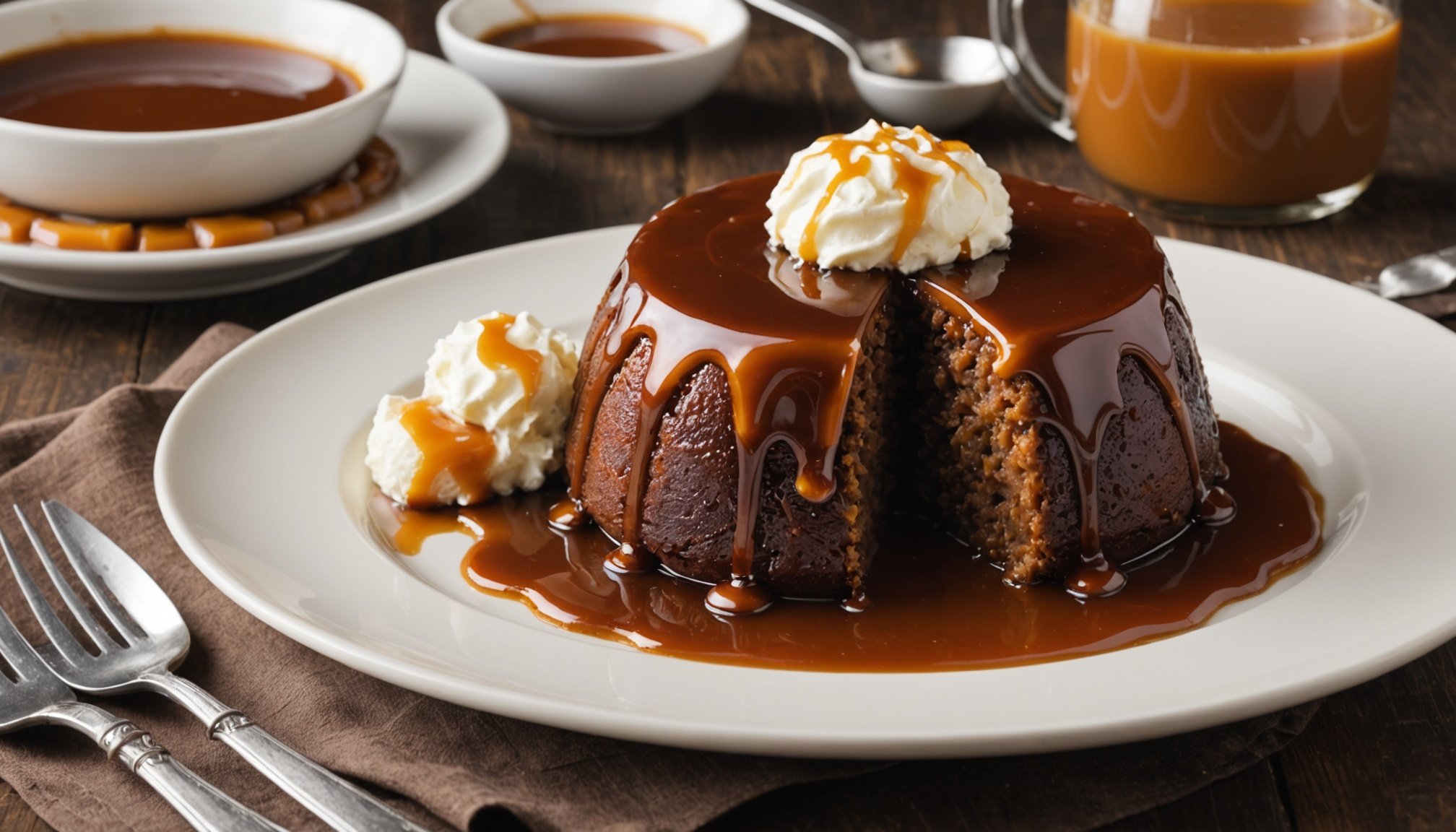Introduction to Sticky Toffee Pudding
Sticky toffee pudding, a beloved dessert hailing from British cuisine, has intrigued dessert lovers and chefs worldwide with its rich history and unique flavour profile. Its origins can be traced back to the culinary traditions of Britain, where it emerged as a sumptuous dessert recipe known for its delightful combination of flavours and textures. This dessert typically features moist sponge cake, often made with dates, covered in a smooth and rich toffee sauce, which epitomises its classic charm.
The traditional elements of sticky toffee pudding set it apart, often including a buttery toffee sauce and a cushiony, date-flavoured cake base. These components together contribute to a luscious taste experience that has helped the pudding maintain its iconic status within British cuisine.
Also to see : Unlock the secrets to perfecting classic english steak and mushroom pie: your complete guide
Over time, sticky toffee pudding has gained popularity beyond British borders, leading to various cultural variations. Different regions have adapted the dessert to suit local palates, experimenting with ingredients like nuts or different fruits. Nevertheless, the core elements of sumptuous sweetness and familiar comfort remain constant, making sticky toffee pudding a timeless favourite. As modern cuisine continues to evolve, this dessert adapts, cementing its place among classic dessert recipes cherished by many.
Ingredient List
Creating a sticky toffee pudding is a delightful experience, with the quality of ingredients playing a crucial role in achieving the perfect flavor. Here’s what you’ll need for your baking adventure:
Additional reading : Elevate your palate: a comprehensive journey through the timeless english breakfast experience
- Dates: A key ingredient for that gooey texture. Make sure they’re pitted and finely chopped.
- Self-raising flour: Provides the pudding with its characteristic rise.
- Butter: Use unsalted, high-quality butter for richness.
- Brown sugar: Essential for that luscious toffee flavor.
- Eggs: They bind everything together, so ensure they’re fresh.
- Golden syrup: Adds a unique sweetness and depth.
- Vanilla extract: Opt for pure extract to enhance the aromatic profile.
- Baking soda: Helps the pudding reach its full fluffy potential.
For those who want to experiment, consider these optional ingredients:
- Chopped nuts: Walnuts or pecans can add a delightful crunch.
- Spices: A dash of cinnamon or nutmeg offers a warm, comforting twist.
Investing in high-quality baking ingredients is paramount for optimal results. Fresh and premium components enhance the flavor and texture, making your sticky toffee pudding truly stand out. With the right mix, you’re on your way to baking success.
Preparation Steps
Creating a delicious sticky toffee pudding starts with mastering the art of pudding preparation. Follow these steps carefully to achieve that perfect, mouth-watering consistency.
Begin by combining dates and water in a saucepan, bringing them to a boil before letting them cool slightly. Puree the mixture until smooth, then add vanilla extract to enhance the flavour. Next, cream together butter and sugar until they reach a light, fluffy texture. This is crucial for achieving that distinctively rich taste.
Incorporate eggs one at a time, blending thoroughly after each addition. Gradually, sift flour and baking powder into the mixture, ensuring everything is well combined. This step is vital in maintaining the ideal batter consistency.
To avoid common mistakes such as overly dense pudding, ensure not to overmix your batter. Overmixing can lead to a loss of texture and fluffiness. Baking instructions further play a critical role. Bake at a preheated oven, around 180°C (350°F) for around 35 minutes, or until an inserted skewer comes out clean.
Avoiding these pitfalls aids in creating the perfect sticky toffee pudding, with its signature moistness and depth of flavour. Properly executing each step and adhering to these instructions ensures a delectable result every time.
Baking Instructions
When learning how to bake pudding, it’s important to find the perfect balance of baking time and oven temperature. For a classic sticky toffee pudding, preheat your oven to 350°F (175°C). This temperature ensures the pudding bakes evenly without overcooking the delicate, moist cake base essential to the dish’s traditional texture. The typical baking time for this favourite is around 30 to 35 minutes, but remember that ovens can vary, so keep a keen eye on your creation!
How do you check for doneness? Insert a toothpick or skewer into the centre of the pudding—it’s done when it comes out mostly clean, with a few moist crumbs clinging to it. The cake should feel slightly springy to the touch. Overbaking can result in a dry texture, so be vigilant.
Upon removing the pudding from the oven, it’s crucial to let it set for about 10 minutes. This resting period allows the pudding to firm, making it easier to serve and enhancing its flavours. This step is often overlooked, but giving the pudding time to set ensures each slice is perfect and flavours meld beautifully. Enjoy your sticky toffee pudding with a cooling scoop of vanilla ice cream!
Making the Warm Caramel Sauce
Creating a warm caramel sauce elevates any dessert. The following step-by-step guide will walk you through crafting the perfect sauce at home. Begin by gathering your ingredients: white sugar, heavy cream, unsalted butter, and a pinch of salt. Start by melting the sugar in a saucepan over medium heat. Stir continuously to prevent clumping and ensure an even melt. Once the sugar dissolves and turns a rich amber, swiftly add the butter, whisking vigorously. This critical step creates the base of your dessert sauces.
Now, you want to achieve the ideal caramel consistency. Gradually stir in the heavy cream, continuing to whisk until it reaches the desired thickness. This addition helps create a smooth, luscious texture that coats the back of a spoon beautifully. Keep a watchful eye on the heat to prevent scorching.
To enhance your caramel sauce, consider incorporating a dash of vanilla extract or a sprinkle of sea salt for added depth. For variations, try infusing your sauce with unique ingredients such as bourbon or espresso. These additions beautifully complement the rich caramel and pair well with various desserts, providing a distinct twist on traditional dessert sauces.
Serving Suggestions
Sticky toffee pudding is a culinary delight best enjoyed with well-paired accompaniments. Here are some recommended ways to serve sticky toffee pudding that enhance its rich flavours.
A classic choice is to pair it with cool and creamy ice cream, which provides a delightful contrast to the warm, gooey texture of the pudding. Vanilla ice cream is most often recommended due to its subtle flavour, which does not overpower the dessert. For those who prefer a more luxurious touch, consider serving it with a dollop of freshly whipped cream.
Presentation is key when serving desserts like sticky toffee pudding. A sprinkle of chopped nuts or a drizzle of toffee sauce can add an eye-catching finish that will impress your guests. Complementing the pudding with fresh fruits, like berries or sliced bananas, not only enhances the presentation but also adds a refreshing note to the sweet dish.
When considering pairing desserts, think about textures and flavours; creamy and mellow options usually work well here. The goal is to create a visually appealing and harmonious dessert experience that delivers both comfort and a touch of elegance. Keep these tips in mind, and your sticky toffee pudding will be the highlight of any meal.
Variations of Sticky Toffee Pudding
Exploring the world of sticky toffee pudding variations offers a delightful journey for dessert enthusiasts. Traditionally known for its rich, caramelized flavor, the classic dessert can be transformed with a variety of innovative recipes. One way to reinvent this beloved treat is by experimenting with different flavor profiles and ingredients. Imagine the addition of tart apple pieces, lending a refreshing twist to the familiar richness, or incorporating nuts for a crunchy contrast.
Seasonal variations also provide an exciting way to enjoy sticky toffee pudding throughout the year. During autumn, a pumpkin spice version can evoke the warmth of the season, blending together the earthiness of pumpkin with aromatic spices such as cinnamon and nutmeg. As winter approaches, a gingerbread rendition might appeal, offering the comforting flavors of molasses and spice.
For those seeking a healthier alternative, adaptations to the traditional recipe are possible. Consider creating a gluten-free version by substituting standard flour for almond or coconut flour. Additionally, reduced sugar options can be achieved without compromising on taste. Natural sweeteners like dates or applesauce can provide the necessary sweetness, offering a balanced yet indulgent treat. These clever variations uphold the scrumptiousness of the classic while catering to a range of dietary preferences.
Visuals and Additional Tips
A recipe visual is essential in capturing each step to ensure clarity and guide novice cooks. When presenting sticky toffee pudding, showcasing instructional photos can elevate comprehension and inspire creativity. These images provide a visual narrative, illustrating ingredient preparation through to the final presentation.
To photograph your sticky toffee pudding creation effectively, focus on lighting and angle. Natural light is usually best to highlight the dessert’s texture and glossy sauce. Try shooting from different angles—overhead shots can showcase the pudding’s entirety, while close-ups emphasise details like the rich toffee glaze. Crafting beautiful, engaging visuals not only enhances the cooking experience but also entices viewers.
Embrace the power of sharing personal cooking tips and variations online. Social media platforms offer a space to connect with a community of fellow pudding enthusiasts. Simple tweaks like adding nuts or experimenting with spices can inspire others. Sharing enhances your own culinary journey and motivates others to innovate upon traditional recipes. Personal experiences and variations bring uniqueness to your content, fostering engagement and dialog among cooks.
Utilising eye-catching recipe visuals and engaging photographs will provide aspiring dessert makers with the insight needed to create delectable outcomes and a sense of accomplishment.











